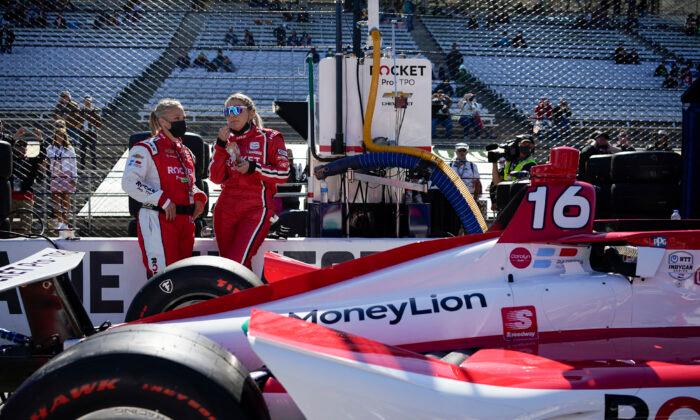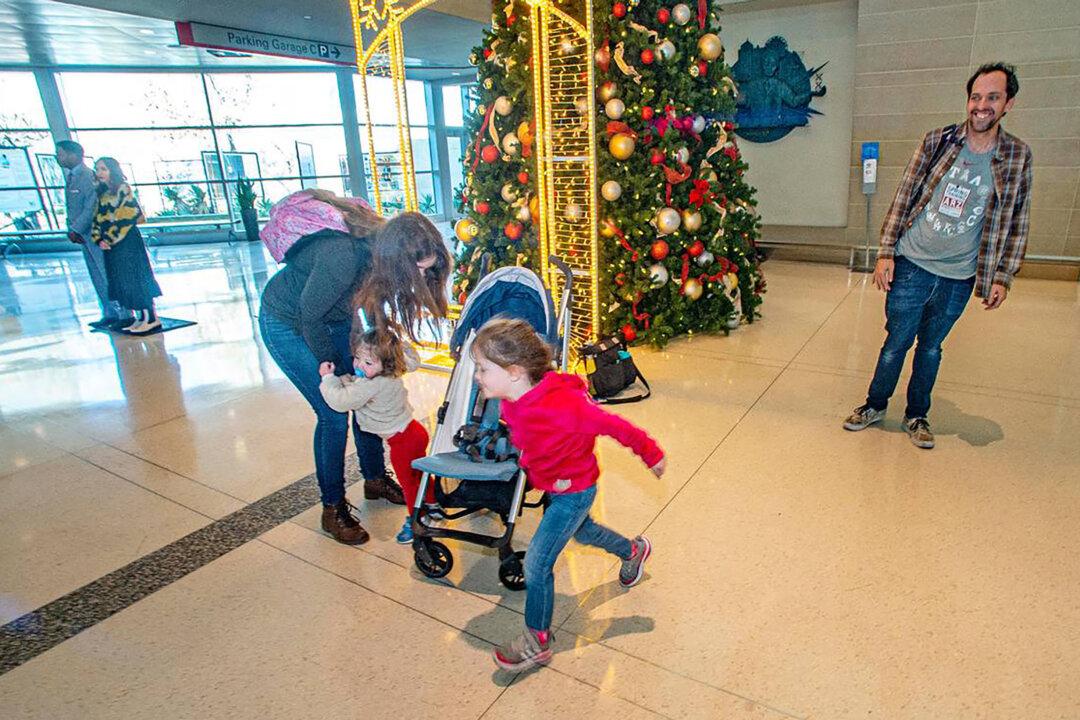CHARLOTTE, N.C.—As a consequence of her jobs working as a server at an Italian restaurant in Concord and as a dog groomer at a south Charlotte pet superstore, Amanda Frayer has never spent much time (OK, any, frankly) fielding phone calls from reporters or signing autographs at major sporting events.
But this spring, the 26-year-old Concord resident added a third occupation to her resume, and in recent weeks, this particular one managed to thrust her into the national spotlight.
On Sunday, Frayer—a former college field hockey player who four months ago knew virtually nothing about professional motorsports—served as the outside rear tire changer for IndyCar driver Simona De Silvestro’s No. 16 Paretta Autosport Chevrolet at the Indianapolis 500.
And Frayer wasn’t the only woman working the pit crew.
Three of the other five individuals who went “over the wall” (i.e. onto the track to work in the pits and on the cars) with her during the race were female. Meanwhile, De Silvestro’s two spotters and two of her engineers were women. Oh, and the front office at Mooresville-based Paretta Autosport is populated exclusively by women, with team owner Beth Paretta running the show.
So, Frayer is now semi-famous because she helped make history at The Brickyard on Sunday: It was the first time in the 105-year history of the Indy 500 that a team composed primarily of women competed in the world’s largest sporting event.
“I would be lying if I said it wasn’t really cool,” Frayer told the Charlotte Observer when asked what all the media attention was like. “Playing sports in high school, you know, you see your name in the local paper every once in awhile. But to (be in national news stories) and then have so many people on my Facebook that I haven’t talked to in years reaching out and being like, ‘Wow, what you’re doing is so cool!’ It was—”
She paused, before repeating, matter-of-factly: “It was really cool. I don’t know how else to explain it.”
How did Frayer—who followed her best friend to the Charlotte area from her hometown of Harpursville in upstate New York in September 2019 “for the heck of it”—go from serving plates of pasta and pampering poodles to being able to change the tire on an IndyCar in five seconds? What’s it been like being a part of such a unique team? And when will she get the opportunity to work at a racetrack again?
She talked about all of those things and more with the Observer by phone on Wednesday morning, while driving to her job at PetSmart. (The conversation has been edited for clarity and brevity.)
Growing up, I played basketball and field hockey, and I played a little bit of field hockey in college. That’s how I kind of got recruited for the pit-crew team. ... Our team is affiliated with Penske Racing. Beth (Paretta) really relied on Penske (employees) to just ask around and ... my good friend’s father works for Penske.
He called me on a Thursday night in February at 9 o’clock. I remember (thinking), “Why is Mr. B. giving me a call?” And he was just like, “Hey, there’s this really amazing opportunity to be part of a female-dominant pit-crew team at the Indy 500 this year. I know you’re athletic and competitive. Is this something you would want to give a try?” I’m a big opportunity taker, so I was like, “Yeah, absolutely.” He goes, “Can you be here tomorrow at 8 a.m. for an evaluation?” I was like, “Uhhh, yeah, sure!”
The next day I went in for an evaluation at one of the Penske shops in Mooresville. I did good there. That Monday was the beginning of tryouts. (They lasted two weeks) and there were nine women that were trying out. Six of us made the cut. So starting in February, up until about two weeks ago, we would go in to the Penske shop at 5 a.m. for an hour practice four days a week. We all chose 5 a.m. to practice because we all had daytime jobs. This was the only time that would work for everybody.
And we didn’t find out until maybe a week before the race who exactly 100 percent for sure was gonna go over the wall. (The three other women on the pit crew for Paretta on Sunday in Indianapolis were Madison Conrad, Caitlyn Brown and Mallorie Muller.)
Yup. So were all the other girls on the team. And I lived about 45 minutes away from the Penske shop, so I got up at about 3:30 a.m. Monday through Thursday for three or four months.
Yeah, what our team did at this Indy 500 was history being made. There hasn’t been a female-dominant team. The majority of the team that went over the wall was women. That’s never been done before. And the message that Beth was trying to get across was she really wants women to be more in motorsports and to be more on that front line. It was getting a lot of attention, and a lot of people were supporting us. And it was just such a great feeling to be a part of something that made history, because not too often can you say that nowadays, that you’re the first one to do something.
(Laughing.) I could, yes. Took me a lot longer than five seconds to do it, but yeah. My dad taught me.
Nope. I’ve been trying to teach myself for years how to change my own oil, but I’ve just given up on that. Yeah, changing a tire was really the only thing that I could do by myself on a regular car.
Yeah, you’d get blisters (under your gloves), before your hands would be used to it. It’s kind of like, if you don’t ever do yardwork outside and you do yardwork all day one day, you’re gonna have blisters on your hands. Your body’s not ready for it. And in the beginning, I wanted to be good at this. So I wanted to do as many reps as possible to try and change this tire the best way that I could, and I just wanted to keep going.
In my job, I hold the gun in my right hand, and then I run around the car and I take the nut off. Most of the time somebody pulls my tire for me, but if they’re not able to, I pull the tire off myself, then I pick up the other big tire and throw it back on the car. It doesn’t sound like much, but if you go to grab the tire the wrong way, you’re gonna hit your hand and scrape it, and if you don’t put the tire on the correct way you’re gonna have bruises all on your arm.
So yeah, the training was intense.
Kind of. Just because it was so far out of my comfort zone. I mean, I groom dogs and work in a restaurant. Throwing tires on a car is totally out of left-field for me. So the mornings when my alarm would go off—and Thursdays were the toughest—it was like, “Man, I would so much rather sleep than go in to practice right now.” But then I would remind myself of this once-in-a-lifetime opportunity. ... We aren’t guaranteed more races this year, or even a season next year. I was so driven to take this opportunity to the fullest extent.
We were in Indy for two weeks before the race started, doing the practices and everything. And three of (the six women Frayer had been training with spent those two weeks) working on the actual IndyCar, ’cause they have like mechanical backgrounds.
But one other girl and I, we didn’t have any mechanical background. Working on the car really wasn’t our cup of tea. So for those two weeks, instead of working on the car, we were part of the pit-box setup and support. We had to set up our whole pit-box lane, with the fueler, set up all the hoses, everything like that. And within the two weeks, we had to move our pit box four times. So we were in charge of breaking it down, moving it, setting everything back up, and then if (the team) needed something down on pit lane it was our job to make sure that it was there.
Oh, 100 percent, yeah. (Laughing.) If I was having this conversation with myself five months ago, I’d be looking at myself like a deer in headlights, thinking, “What are you talking about? What does any of this mean?”
Oh, man. It was really cool. So we all met up on Gasoline Alley, where all the garages are, and before the race, all the women on the team—with Beth and Simona—we all walked down Gasoline Alley, down pit lane. People were cheering for us, waving at us, saying like, “Yeah, let’s go Simona! You guys got this! Kick butt!” ... I put my hand up and waved, and then they started cheering even more. It was just like— like, this doesn’t happen to me. I got all giddy and had goosebumps.
Yeah, there were a couple people that came up and were just like, “Oh my gosh, can you sign this?” And I was like, “Oh yeah, for sure!” I felt important. (Laughing.)
There was a little bit of an adrenaline rush, because being the female-dominant team, there were a lot of eyes on us. Whether it was rooting for us, or watching our every move to see if we make a mistake. So the first time, you see Simona’s car coming in, and you did the stop like normal. After the stop is when it really hit, like, “Holy crap, we just did a stop over the wall at the Indy 500!” Our coach said it was a smooth stop. Everything went perfectly. He came over, fist-bumped all of us and we were all so proud of ourselves, that ... we did it, and we did it successfully.
We got four pit stops in. ... Unfortunately for our team, with about 30 laps to go, Simona’s brakes locked up coming into pit lane and the back right side ran into the wall. It got a little bit too damaged, so we were unable to finish the race. So I’d say probably around five or six on average.
There were rumors going around while we were at Indy that we would be at two more races this year. But being how that’s not an official go-ahead, it’s kind of up in the air. We got an email (saying) to hang tight I guess, to see what Beth has in store for us. I mean, I’m excited and hopeful that we get that call that says, “Hey, let’s do this race.” But as of right now, I’m just gonna continue my day jobs and get back to reality.
Well, I think another thing that Beth was trying to get across is just getting people to do things that they normally wouldn’t do. In my case, I wouldn’t normally do this. I do my day job. ...
(I met) one of the guys that’s down on pit lane. Not a firefighter, but a fire rescue type guy; in case there’s a fire that breaks out, he runs to the fire. He said he’s been doing this for 20 years, and because of what we were doing, his wife for the first time actually came to the race in person and watched it. I’m unsure of what disease she has exactly, but I know she’s bound in a wheelchair, so it was very difficult for her (to come). And she probably never would’ve done this if we hadn’t been out there promoting this message to do things that you normally wouldn’t do.
I thought that was amazing.





